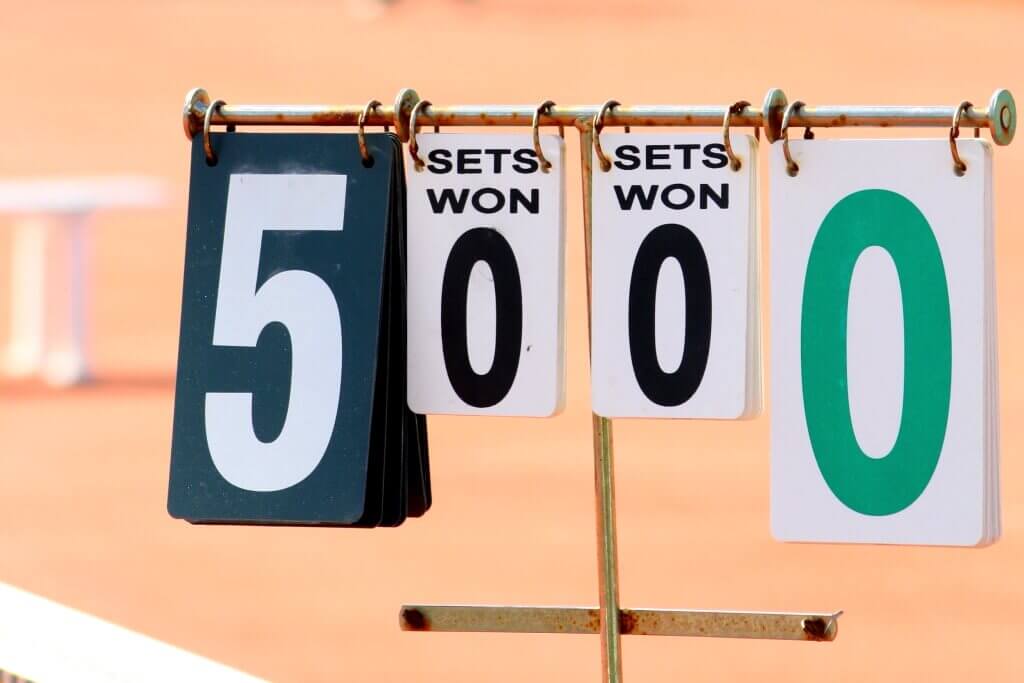Tennis is a great sport and a lot of fun, but it does have one of the strangest forms of scoring in sports. This guide will help you learn how to keep score in tennis, so eventually, it will be much easier to digest.
Basic Framework of a Tennis Match
At the beginning of a match, both players are set at zero which is called “Love-all.” If one player scores: 15 to love, the server’s score is announced first then the receiver’s as second. The second player scores one point so they are now tied at “15-all”. The next score is 30, then 40, and the fourth point will win the game. If the players tie at 40, it’s called a deuce. From that point, the next player who scores a point has the advantage but normally must win by two points. That means scoring twice in a row to win the match. There is more to this, six or more of these games make what is called a set, and the set must be won by two games or it goes to a tiebreaker. Once the set is over, it will repeat. To win the entire match requires either winning three of five sets or two of three sets, depending on the competition.
History of Tennis Scoring
At one time, it was thought the clock faces were used to keep score with a quarter movement of the minute hand to indicate a score of 15, 30, and 45. When the hand moved to 60, the game was over.
In order to make certain that the game could not be won by a one-point margin, deuce was introduced. To make the score stay within 60 ticks on the clock, the 45 was altered to 40. Hence, If both players tie at 40-40, the first player to score a point would receive 10 and that would move the clock to 50. If the player won a second point before the other player could score, they would receive another 10 and the clock would move up to 60. If a player failed to score twice in a row, the clock would move back to 40 creating another deuce.
It is also believed that the scoring terminology came from the French game Jeu de paume, which translates in English to “Palm Game”. This was the forerunner to tennis in which players used their hands to hit the ball, instead of using racquets. The game was very popular in France before the French Revolution.
The standard Jeu de paume court was 90 feet in length with 45 feet on either side. A player would start the game behind the line, if a player won a point, they were allowed to move 15 feet closer to the net. After the second point, the player would move another 15 feet. After the third point, the player would move 10 feet, which would place them 5 feet from the net.
Gameplay
Each player is allowed only one bounce on their side of the court to return the ball to the opponent’s side within the court boundaries. If the player fails to return the ball, the opponent gets the point. The one exception is wheelchair tennis in which players are given two bounces.
Scoring a Game
Counting points in tennis is different from other sports. With most sports, it’s the common “0, 1, 2, 3…” Instead, the terminology used for points is as follows:
- 0 points = “Love”
- 1 point = 15
- 2 points = 30
- 3 points = 40
- Tied score = All
- 40-40 = Deuce
- When players tie at 1 point each, it’s called “15-all”
- When players tie at 2 points, it’s called “30-all”
- When players tie at 3 points, it’s called deuce, not “40-all”
- Server wins deuce point = Advantage In or “Ad-In”
- Receiver wins deuce point = Advantage Out or “Ad-Out”
So how to win a game of tennis? A player or team must win at least four points with a margin of two points to win the game. If a player is up by 40-love, 40-15, or 40-30 and wins one more point, the player wins the game. If the score is tied, the term “all” is used when announcing the score.
If deuce (or 40-40) is reached in a tennis game, one player will have to win two consecutive points to win the game. When the server wins the deuce point, it is called Advantage In or “Ad-In”, but when the receiver wins the deuce point, it’s called Advantage Out or “Ad-Out”. If the player with the advantage wins another point, they win the game. But if the other player wins the point, the score goes back to deuce.
Scoring a Set
Now that you have a general idea of how to win a game, let’s take a closer look at how to win a set. For a player or team to win a set, they must win six games with an advantage of two games. That said, two common set formats will decide how a set will end.
Tiebreak Set
In a tiebreak set, a player must win six games to win a set. If the score gets to “5-all”, one of the players must win the next two games to win the set. If the score reaches “6-all” in the set, the players will enter a “7 Point Tiebreak” game. Whoever wins the tiebreak game wins the set by a score of seven games to six “7-6”.
To start the tiebreak game, the player who is due to serve begins by serving one point. The opponent then serves the next two points. From that point on, the players alternate serving two consecutive points each until the end of the game. At every six points, the players change ends of the court. This in turn maintains fair play by preventing any environmental advantages including glare of the sun and wind direction.
To win the tiebreak game, a player must reach a minimum of seven points and have a two-point advantage over their opponent. If one player has six points and the other has five, and the player with the lead scores the next point, they win the game and the set. On the other hand, if the players are tied at six points, it would not matter who won the next point because no one could achieve a two-point lead. Instead, they would continue playing until one of them managed to pull away.
Advantage Set
In an advantage set, the first player to win six games with a lead of two games wins the set. This is unlike a tiebreak set, if a score of 6-6 has been reached, the set continues until either player gets a two-game lead.
Scoring a Match
Most tennis matches are played as best of three sets. This means the first player to win two sets wins the match. However, some professional tennis tournaments are played as best of five sets, where the first player to win three sets wins the match.
Final Words
There is no doubt, tennis scoring can be very confusing but hopefully, after breaking down the games, sets, etc, you have a better understanding of how tennis scoring works. If you are looking to become more proficient in keeping score, I would recommend playing as much and as often as possible. The best way to learn is to get out there and play the game.







